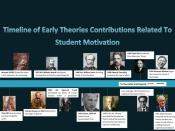Introduction.
There are amounts of definition of motivation in very broad fields. Motivation can be defined as the psychological process that gives behaviour purpose and direction (Kreitner, 1995); a predisposition to behave in a purposive manner to achieve specific, unmet needs (Buford, Bedeian, & Lindner, 1995); an internal drive to satisfy an unsatisfied need (Higgins, 1994); and the will to achieve (Bedeian, 1993). Accordingly, motivation is operationally defined as the inner force that drives individuals to accomplish personal and organizational goals.
In the rapidly changing workplaces, companies have to motivate employees in order to survive. Motivated employees are more productive and creative, which help the organization reach its profit goals. Thus, managers need to understand the different needs and wants of their employees and what motivates them within the roles they perform. However, motivating employees is arguably the most complex due to the fact that what motivates employees changes constantly (Bowen & Radhakrishna, 1991).
For example, research suggests that money becomes less motivated factor as employees' income increases (Kovach, 1987). Despite of that, interesting work becomes more of a motivator when employees get older.
Therefore, from the point of view, motivation is very important for any companies and organizations. However, when managers motivate their employees, 80-20 rules applies, which indicates that the relationship of the input and output is not balanced. The most intractable employees take up a disproportionate amount of one's time and energy. How to motivate these problems people is a big challenge for managers.
Generally speaking, "The problem person is the person whose behaviour is giving you a problem" (Honey,1996). In organization, any people who can not fulfil organizational objectives and goals can be defined as problem people. Professor Yu (2002) stated employees could be basically divided into four different types:
1. People with ability and tendency/will...


